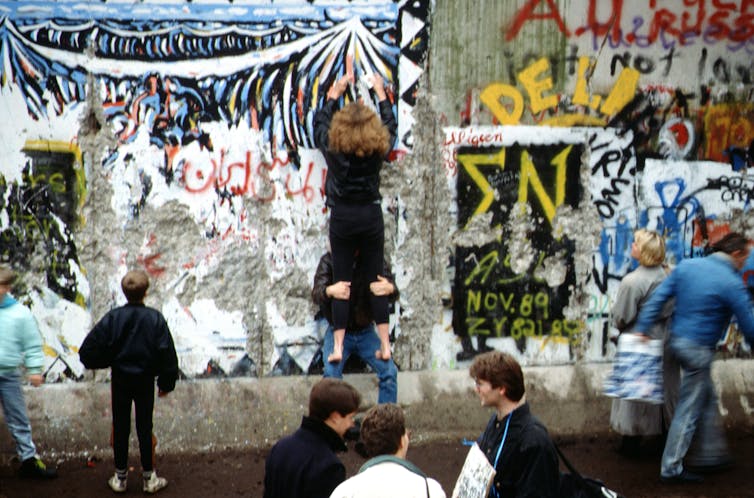
When the Wall came down: Berlin 1989.
Raphaël Thiémard, CC BY-SA
In the wake of the demolition of the Berlin Wall in November 1989, something strange and wonderful happened. Youth from both East and West Germany converged on the space cleared by the wall’s demolition to party – and their preferred soundtrack was techno music.
Much has been written about the role of techno in Berlin and music’s power to create or enhance social cohesion. Three conditions had to be met in 1989 Berlin for music to take on this role: young people were needed who were eager to dance and unafraid of new experiences, social entrepreneurs to organise these raves and available space to set up the decks and dance floors.
In the mid 1980s, with perestroika and glasnost reverberating in East Germany, churches started playing an increasingly important role in East Berlin. Although churches had continued to operate in the GDR, it took conviction and courage for people to show their opposition to a communist regime. Churches continued to provide safe spaces for people to peacefully congregate. But they were also explored as alternative venues for concerts.
Bluesmessen (church services with music for young people) became increasingly popular, as these events were not governed by the GDR law (Veranstaltungsgesetz) and escaped state censorship. After years of artistic censorship through the Lektoratskommission (a state assessment panel for lyrics and music) and the need for the permits to play pop music live (Spielerlaubnis), what young people in East Germany wanted was to be authentic and immediate.
The West German punk band Die Toten Hosen, for example, played two illegal gigs in 1983 and again in 1988 at churches in East Berlin. The need to produce and consume nonconformist music was evident long before the wall came down.

West German punk band, die Toten Hosen, playing the Hoffnungskirche in East Berlin, 1988.
Mark Reeder, Author provided
But what was perhaps needed was a new kind of music – something not as culturally or politically loaded as punk, for example, which meant different things in the two parts of the city (not least because punks did not officially exist in the GDR). And then techno happened.
Unification through dance
In 1989, two different youth cultures met on the dance floor. West Berlin was known as a place in which young men from West Germany could avoid military service because of its demilitarisation after World War II. This lack of compulsory military service tended to attract a particular kind of young person, one that helped define a very alternative, creative and artistic scene in West Berlin.
Out of this scene came entrepreneurs who were used to organising parties and continued to do so in parts of the city that had become available when the Wall was demolished. Abandoned buildings on the former death strip that had previously divided the city were soon appropriated as dance spaces. The newly elected Berlin Senate condoned this, even though many of these spaces were being used illegally.
It is in here that the social entrepreneurs of West Berlin met young people from East Berlin who wanted to express themselves authentically and without state surveillance. The act of dancing helped to connect people in a way that politics in Germany still to this day struggles to achieve. Many East Germans continue to feel inferior and see German unification as an annexation of their former state, losing their currency (and for many, their savings), their educational system, employment protection and even their street names. Nobody ever told them what a free market economy means and how you compete successfully for jobs, pay raises or promotions.
Dancing became a way for young people to connect through bodies rather than words – and techno in Berlin provided a clean canvas for young people to feel part of society in a way that perhaps politics did not.
Rise of the ‘Easyjetset’
The enthusiasm and dedication of some of the social entrepreneurs from the 1980s and 1990s has resulted in a vibrant music scene in Berlin today. In fact, Berlin’s techno scene has become so famous that tourists visit Berlin to not necessarily satisfy their historical interests but to go clubbing – the Easyjetset.
Read more:
This development has allowed Berlin to market itself as the “capital of techno”, showing the value that both tourists and the Senate of Berlin assign to electronic music in the city. It is further evidenced in the way that the city tries to save some of its unique (sub)cultural spaces through subsidies, something that London is failing to do.
Many of the people who organised parties and concerts back then have become important social and cultural commentators and contributors to the culture of the city and beyond. For example, Mark Reeder, who organised the illegal concerts of Die Toten Hosen in the 1980s, which created opportunities for young people in East Berlin to congregate and express themselves, continues to work in the city as label owner (MfS) and cultural commentator.
Dimitri Hegemann gave us the famous Tresor nightclub. The techno music that Tresor championed, is now considered to have provided the soundtrack for German unification. Hegemann is an influencial international cultural commentator and entrepreneur who continues to develop interesting projects that benefit the city as well as rural Germany.
Unification is complete on the Berlin dance floors. Berliners and tourists benefit from this coming together of creative energy, enthusiasm and dedication. Wouldn’t it be wonderful if music managed to unite the rest of the country in a similar way?
Beate Peter, Senior Lecturer, German, Manchester Metropolitan University
This article is republished from The Conversation under a Creative Commons license. Read the original article.